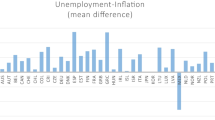Abstract
This paper examines the dynamic impact of anticipated government spending on real exchange rates in a general-equilibrium framework. I show that an increase in government spending causes persistent movements in real exchange rates, and that the time profile of real exchange rates differs with patterns of government spending. Hence, one of the explanations for the misalignment and excess volatility of real exchange rates during the flexible exchange rate system may be volatile changes in government spending.
Similar content being viewed by others
References
Aschauer, D.A. (1985) “Fiscal Policy and Aggregate Demand,”American Economic Review 75, 117–127.
Barro, R.J. (1989a) “Government Spending in a Simple Model of Endogenous Growth,”Journal of Political Economy 98, S103–125.
—— (1989b) “The Neoclassical Approach to Fiscal Policy.” In R.J. Barro (ed),Modern Business Cycle Theory. Cambridge: Harvard University Press, pp. 179–234.
Blanchard, O. and S. Fisher (1989)Lectures on Macroeconomics. Cambridge: MIT Press.
Blinder, A.S. and R.M. Solow (1973) “Does Fiscal Policy Matter?”Journal of Public Economics 2, 319–338.
Bruce, N. and D.D. Purvis (1985) “The Specification of Goods and Factor Markets in Open Economy Macroeconomic Models.” In R.W. Jones and P.B. Kenen (eds),Handbook of International Economics, Vol. II. Amsterdam: North-Holland, pp. 807–857.
Cole, H.L. and M. Obstfeld (1991) “Commodity Trade and International Risk Sharing: How Much Do Financial Markets Matter?”Journal of Monetary Economics 28, 3–14.
Dellas, H. (1986) “A Real Model of the World Business Cycle,”Journal of International Money and Finance 5, 381–394.
Devereux, M. and D.D. Purvis (1990) “Fiscal Policy and the Exchange Rate,”European Economic Review 34, 1201–1211.
Dornbusch, R. (1976) “Expectations and Exchange Rate Dynamics,”Journal of Political Economy 84, 1161–1176.
Fleming, J.M. (1962) “Domestic Financial Policies Under Fixed and Under Flexible Exchange Rates,”International Monetary Fund Staff Papers 9, 369–379.
Frenkel, J.A. and A. Razin (1985) “Government Spending, Debt, and International Interdependence,”Economic Journal 95, 619–636.
—— (1987)Fiscal Policy in the World Economy, Cambridge. MIT Press.
Hall, R.E. (1971) “The Dynamic Effects of Fiscal Policy in an Economy with Foresight,”Review of Economic Studies 38, 229–244.
Hodrick, R. (1980) “Dynamic Effects of Government Policies in an Open Economy,”Journal of Monetary Economics 6, 213–239.
—— (1988) “Risk, Uncertainty and Exchange Rates,”Journal of Monetary Economics 21, 433–459.
Judd, K.L. (1985) “Short-Run Analysis of Fiscal Policy in a Simple Perfect Foresight Model,”Journal of Political Economy 93, 298–319.
King, R.G., C.I. Plosser, and S.T. Rebelo (1988) “Production, Growth and Business Cycles: I. The Basic Neoclassical Model,”Journal of Monetary Economics 21, 195–232.
Kormendi, R.C. (1983) “Government Debt, Government Spending, and Private Sector Behavior,”American Economic Review 73, 994–1010.
Lucas, J.R. (1982) “Interest Rates and Currency Prices in a Two-Country World,”Journal of Monetary Economics 83, 335–360.
Mankiw, G.N. (1987) “Government Purchases and Real Interest Rates,”Journal of Political Economy 95, 407–419.
Marston, R.C. (1985) “Stabilization Policies in Open Economies.” In R.W. Jones and P.B. Kenen (eds),Handbook of International Economics, Vol. II. Amsterdam. North-Holland, pp. 859–916.
Mundell, R.A. (1968)International Economics. New York: Macmillan.
Mussa, M. (1982) “A Model of Exchange Rate Dynamics,”Journal of Political Economy 90, 74–104.
—— (1986) “Nominal Exchange Rate Regimes and the Behavior of Real Exchange Rates: Evidence and Implications.” In K. Brunner and A.H. Meltzer (eds),Real Business Cycles, Real Exchange Rates and Actual Policies. Carnege Rochester Conference Series on Public Policy 25, pp. 117–213.
Obstfeld, M. and A.C. Stockman (1985) “Exchange-Rate Dynamics.” In R.W. Jones and P.B. Kenen (eds),Handbook of International Economics, Vol. II. Amsterdam: North-Holland, pp. 917–977.
Penati, A. (1987) “Government Spending and the Real Exchange Rate”,Journal of International Economics 22, 237–256.
Phelps, E. (1966)Golden Rules of Economic Growth. New York: Norton.
Sargent, T.J. (1987)Dynamic Macroeconomic Theory. New York: Academic Press.
Stockman, A.C. (1987) “The Equilibrium Approach to Exchange Rates,” Federal Reserve Bank of Richmond,Economic Review 2, 12–30.
Turnovsky, S. (1985) “Domestic and Foreign Disturbances in an Optimizing Model of Exchange-rate Determination,”Journal of International Money and Finance 1, 151–171.
Wilson, C.A. (1979) “Anticipated Shocks and Exchange Rate Dynamics,”Journal of Political Economy 87, 639–647.
Author information
Authors and Affiliations
Rights and permissions
About this article
Cite this article
Wu, JL. Fiscal announcements and real exchange rate dynamics. Open economies review 5, 177–190 (1994). https://doi.org/10.1007/BF01000486
Issue Date:
DOI: https://doi.org/10.1007/BF01000486




